Speak up: Finding your voice as a designer in the world of CAD
by jacquie_dealmeida | June 13, 2016 9:00 am
By Gary Dawson
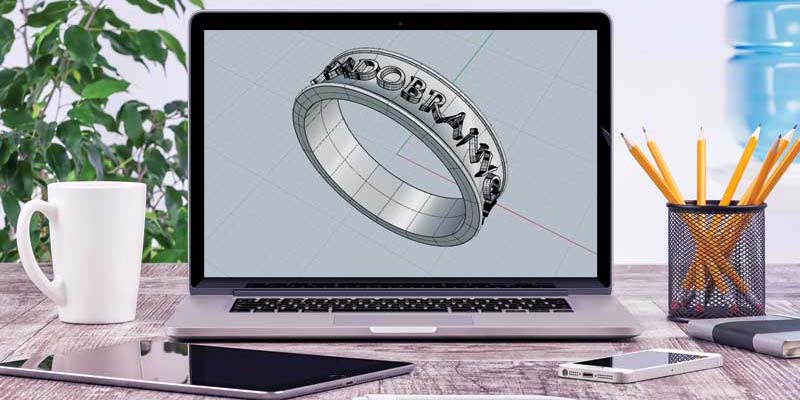 Having a ‘voice’ can mean many things within the jewellery industry. For a designer, it may suggest having a style and maintaining it or perhaps preserving a standard across styles, as I will discuss later. For a jewellery retailer, voice may refer to how their store is branded and/or its position in the community.
Having a ‘voice’ can mean many things within the jewellery industry. For a designer, it may suggest having a style and maintaining it or perhaps preserving a standard across styles, as I will discuss later. For a jewellery retailer, voice may refer to how their store is branded and/or its position in the community.
Organizations within our industry have their voice, some advocating for and promoting the craft of what we do, while others, how we conduct our business. As an industry, we probably also have some sort of unified voice, as it is publically perceived. And importantly, we help our consumers establish and maintain their unique voice with our offerings.
With the fairly recent innovations of CAD/CAM and new marketing strategies for new generations, we as an industry—and as individuals within it—may benefit from a re-evaluation of the concept of voice. Becoming aware of one’s voice and from where it arises may be an important key to competitiveness in the marketplace. And as a custom designer who has recently adopted some of these new technologies, I find my ideas about establishing and maintaining my voice are changing.
Listening carefully
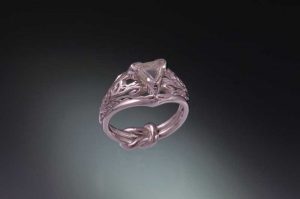
Artists are usually encouraged to ‘find their voice’ early on, especially when they begin their career in an academic venue. Finding a voice in that context usually means discovering or adopting a recognizable style and then working exclusively within it. This, they are told, is the road to commercial success.
A rare few manage to establish themselves to the point they can stretch that style or even successfully adopt another one, never losing their following or what set them apart from their colleagues. Looking outside our industry, Picasso is a classic example of an artist who was able to transition through several styles or periods—from his very early academic realism to what may have become his most commonly recognized style, cubism. He then moved past cubism to classicism and a surrealism period.
For me, specializing in custom-made jewellery has presented an interesting challenge with regard to finding a voice. As a custom designer, my style has always been necessarily eclectic. One client wants something floral and busy, while another wants something clean, simple, and bold. Yet another wants a ‘futuristic’ design, which is in contrast to the client who prefers something that looks antique or timeless. Finding a voice within the cacophony of client desires can be challenging. That said, I felt I had achieved one of sorts many years ago when clients began telling me they could recognize one of my rings when they saw it. I like to think that within many style types, I’ve achieved an elegance of execution that makes my work distinctive. The feedback and success with which I’ve been rewarded seem to confirm that premise.
From there to CAD
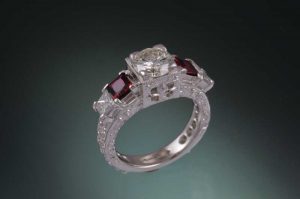
I had been fascinated by the prospect of computer design for a number of years before I actually embraced it. Finding a voice—perhaps a new one or with a different tone—by using a completely new approach to the design process was intimidating in many of the same ways learning a new language can be. It is difficult for someone who is very fluid in their native language to accept the fact that for some time during the learning process, they will communicate like a three-year-old. In addition, I took a road that was, in its implementation, perhaps more difficult. There are many jewellery-specific applications that make the design process easier, although they may ultimately make it harder to find a voice in that they compel one to use the same preforms as everyone else with that particular application. For the same reason I refused to look in jewellery store windows when I began my design career, I chose a bare-bones application that allowed me to find my way without necessarily walking down a well-worn jewellery path.
I was lucky in that once I embraced CAD, I was able to integrate it into my design process a little at a time, using it first to make the simplest objects or ones that did not necessarily require much of a voice. A simple band with a phrase is a good example. As time has progressed and with many more hours invested into the CAD experience, I find myself developing my voice within this new language of CAD. Voice rediscovered!
When everyone sounds the same
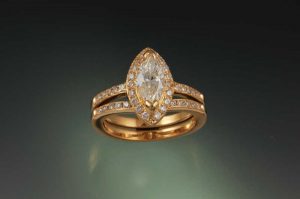
Maybe this primarily reflects my own awakening, but I think we have begun to suffer from stagnation in the jewellery industry in terms of creative use of the new tools available to us. CAD has been around long enough for us to get past the beginner’s mistake of thinking, “Now that we can do this, we should.” Another halo ring anyone? Sheesh! Is it really a great idea, for example, to design and manufacture jewellery with tiny diamonds (or gems that are even more fragile) everywhere on the design?
It becomes a vicious cycle when consumers see a certain design style that is, in the beginning, innovative, though quickly becomes less so as more and more designers and manufacturers follow the trend. Don’t get me wrong—some of the micro-pavé stuff out there is esthetically stunning. But does it serve our industry to create an entire generation of this type of design?
I suppose it will keep our repair shops busy, but is that the legacy we wish to leave for the next wave of jewellery designers, marketers, and consumers? As we examine current design stagnation, a valid question might be, “Is this our voice or the computer’s voice speaking?”
Moving on
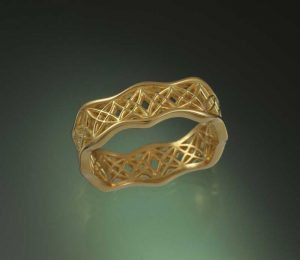
In Zen Buddhism, Shoshin is described simply as the ‘beginner’s mind.’ Watch any two-year-old and you will see one in action. At that stage of life, using a beginner’s mind comes pretty easy, since that is nearly all one has to experience the world. The toddler’s approach to learning is not much imposed upon by prior experience. Conversely, later in life, when we have deep experience in something—anything really—we tend to bring expectations of mastery and a set of paradigms that can constrict our further learning. Applying the beginner’s mind to the new tools in our design process may be helpful as we move away from the idea of, “Now that we can do this, we should.”
Stephen Covey, the author of The 7 Habits of Highly Effective People, has a quick and effective way of looking at the topic of finding a voice. He maintains the following:
“Voice is the overlapping of the four parts of our nature: our body, our mind, our heart, and our spirit, and poses four questions:
1) What are you good at? That’s your mind.
2) What do you love doing? That’s your heart.
3) What need can you serve? That’s the body.
4) And finally, what is life asking of you? What gives your life meaning and purpose? What do you feel like you should be doing? In short, what is your conscience directing you to do? That is your spirit.”
Covey goes on to say that “people are internally motivated by their own four needs: to live, to love, to learn, and to leave a legacy. And when they overlap, you have voice—your calling, your soul’s code.”
This seems particularly suited to makers as stated, though with modification could also be applied to those who simply seek to express their voice through the jewellery they wear. It might go something like this:
1) What do you look good in?
2) What are you attracted to?
3) How does what you wear speak to your ethics?
4) And finally, how does wearing a certain thing make you feel?
A blog post by Leo Babauta on a site called Zen Habits has wonderful tidbits for writers and again, it may be suitable to apply his wisdom to both making and wearing jewellery. His advice is to find what feels true and to write a lot of it. Most of it may not be very useful to you, but you need to do this if you want to recognize the truth—by feel, as he puts it—not by any logical criteria.
My take on this for makers is simply to make many things, something I have coached my students about continuously. For it is in the making that you will find yourself over the years.
The next era
My friend, Rafael, thinks we are on the verge of the next great design revolution. I think we in the jewellery industry had absolutely better be! We have the ability to design things unimaginable a few short years ago and that, of itself, is a fantastic opportunity. I am not sure we have yet embraced that potential. To be (or remain) competitive in the marketplace with the distractions of electronics and other must-haves, we need to start thinking a bit more strategically.
Pulling a quote out of context from a website called Fast Company, I will leave something for our industry to ponder. This was written primarily as advice for marketing to millennials, but I think it has a broader perspective.
“Great design streamlines, clarifies, and delights—and the most complex or chaotic experiences need it most of all. But here’s the rub: For Millennials, design is not a differentiator—it’s a cost of entry. Every startup looking to re-imagine broken industries, whether it’s housing or health care, has one thing in common: well-designed experiences. And every established giant within that same system tends to be plagued by the reverse.”
Your voice is how people perceive you, it is your brand, and it can be your direction. Think clearly about how you want to present it.
 Gary Dawson is owner of Gary Dawson Jewelry Designs, an online custom design operation that was once featured as a “Best of the Best” by Instore Magazine, as well as Dawson Distributions LLC, a supplier of CAD/CAM solutions for jewellers. Dawson has more than 40 years’ experience in creating designs that capture the personalities and stories of his customers, and he is a frequent contributor to MJSA Journal. He has also delivered seminars and presentations at numerous events, including AGTA GemFair, Portland Jewelry Symposium, and the Santa Fe Symposium on Jewelry Manufacturing Technology. Dawson can be reached via e-mail at gary@garydawsondesigns.com.
Gary Dawson is owner of Gary Dawson Jewelry Designs, an online custom design operation that was once featured as a “Best of the Best” by Instore Magazine, as well as Dawson Distributions LLC, a supplier of CAD/CAM solutions for jewellers. Dawson has more than 40 years’ experience in creating designs that capture the personalities and stories of his customers, and he is a frequent contributor to MJSA Journal. He has also delivered seminars and presentations at numerous events, including AGTA GemFair, Portland Jewelry Symposium, and the Santa Fe Symposium on Jewelry Manufacturing Technology. Dawson can be reached via e-mail at gary@garydawsondesigns.com.
Source URL: https://www.jewellerybusiness.com/features/speak-up-finding-your-voice-as-a-designer-in-the-world-of-cad/

